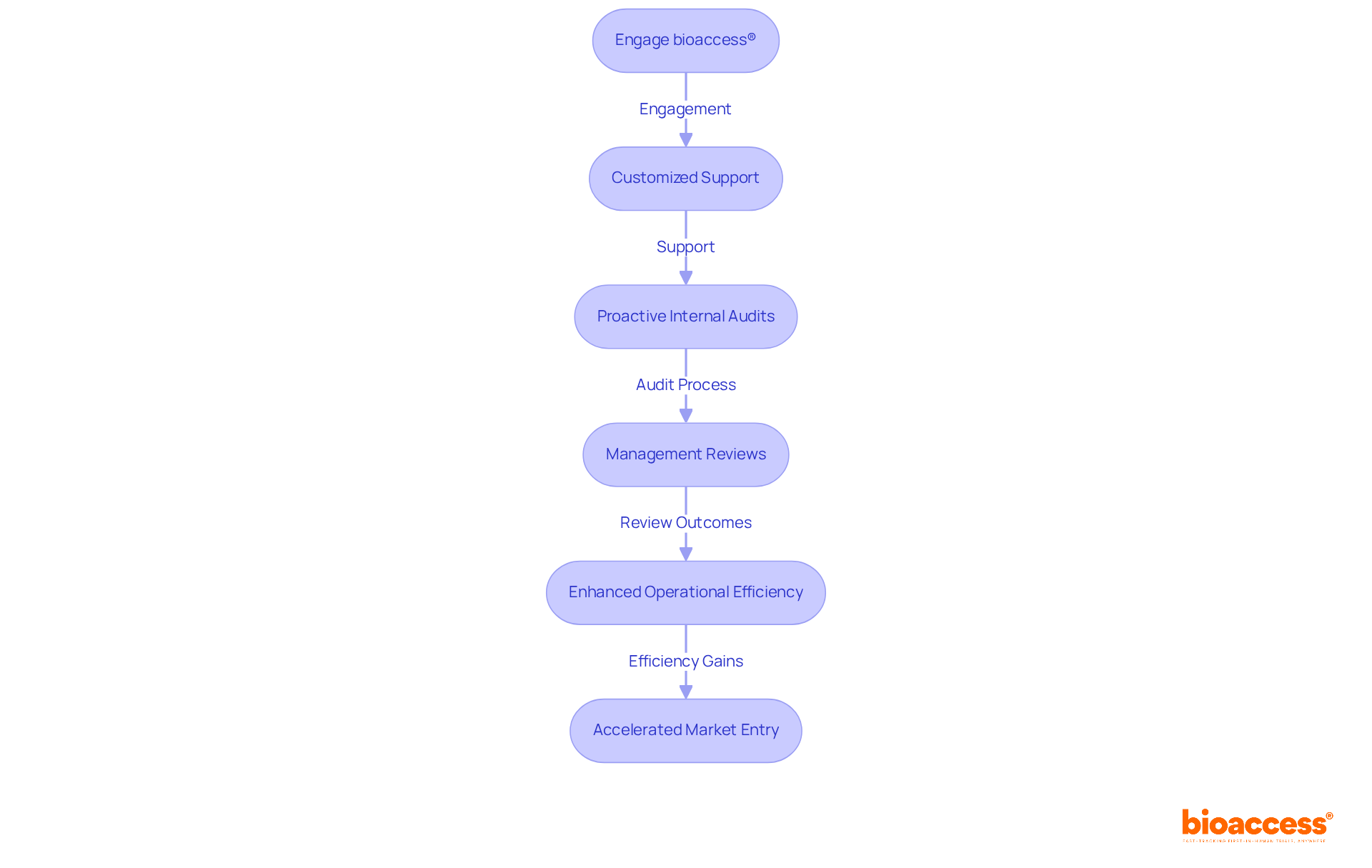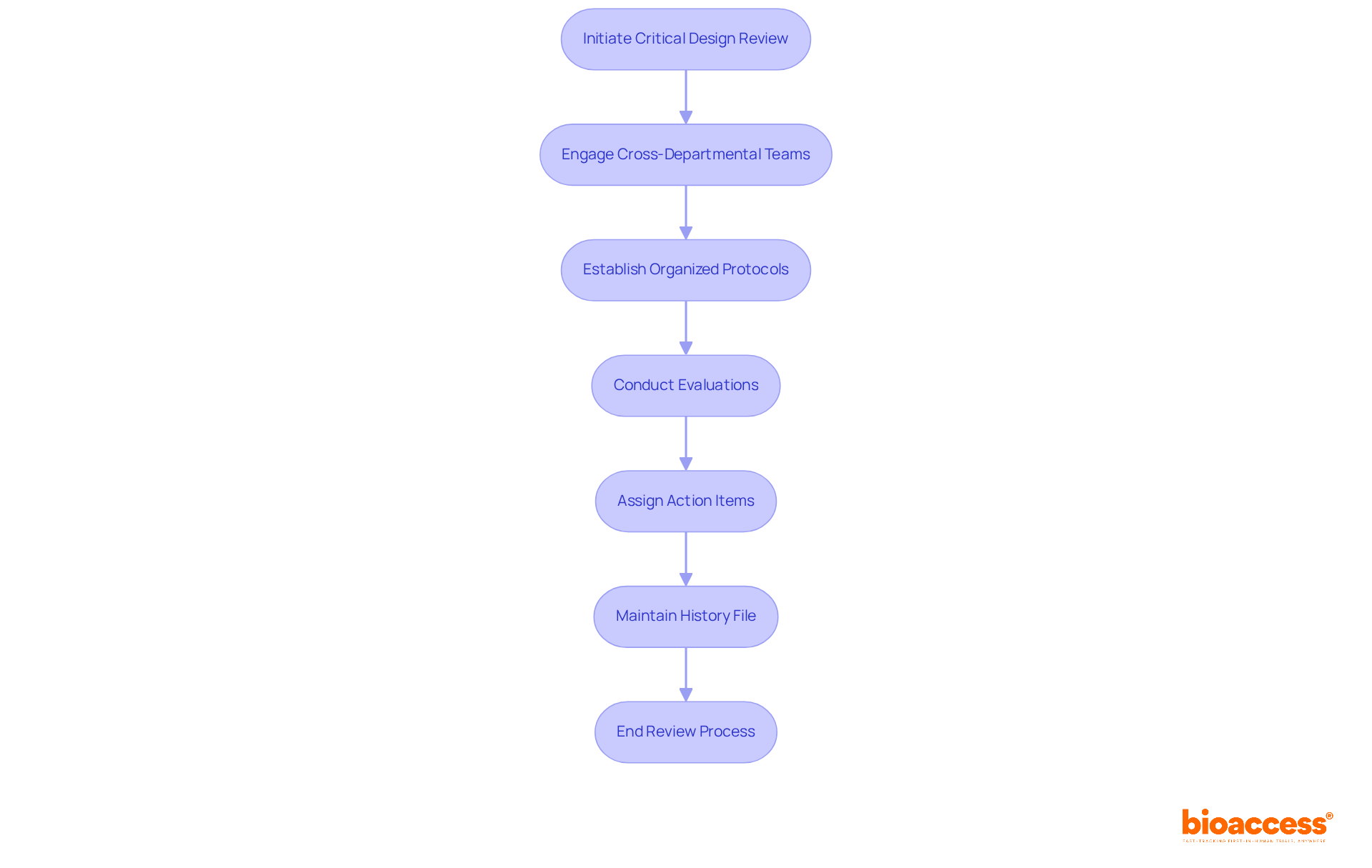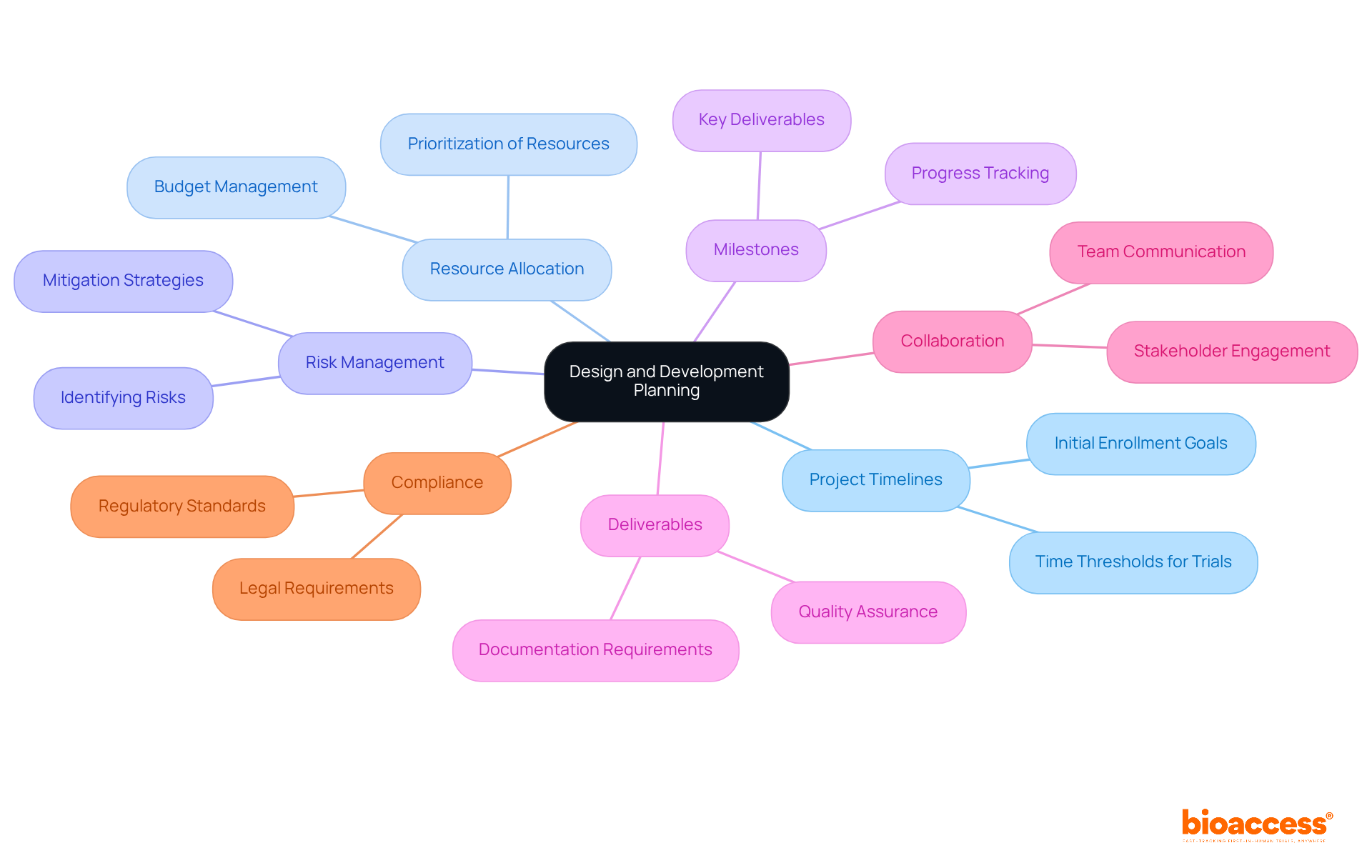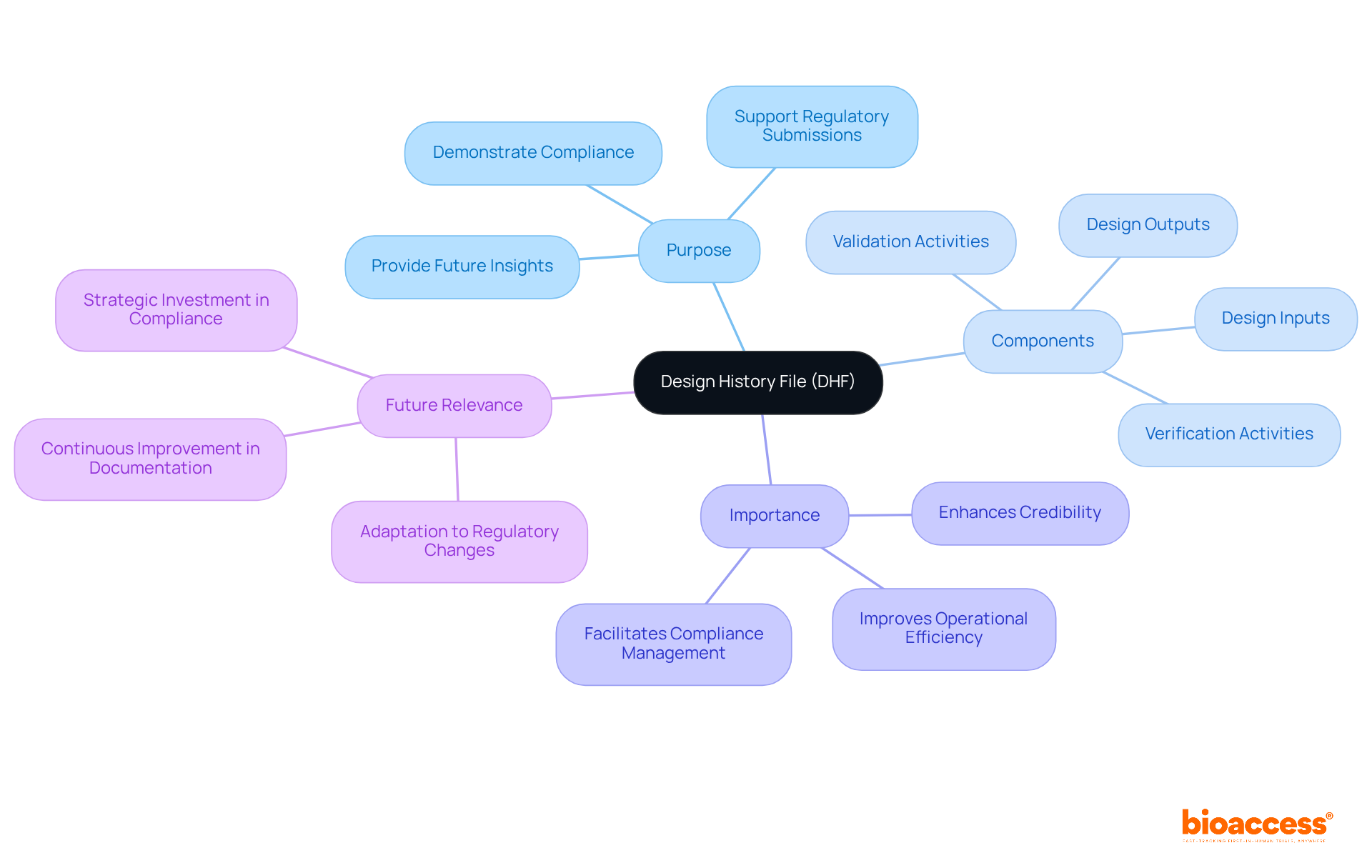


The primary focus of the article titled "10 Essential Design Control Guidance FDA Tips for Clinical Research Leaders" is to equip clinical research leaders with crucial strategies for effectively navigating FDA design control regulations. It highlights the importance of understanding and implementing these design controls—such as:
These are essential practices that can significantly enhance compliance, mitigate the risk of product recalls, and accelerate time to market. These factors collectively support the overall success of medical device development.
In the high-stakes world of clinical research, ensuring compliance with FDA regulations is not merely a necessity; it represents a critical pathway to success. As the regulatory landscape grows increasingly complex, clinical research leaders confront the daunting challenge of navigating design control guidance while simultaneously fostering innovation and quality. This article explores ten essential tips designed to empower leaders to deepen their understanding of FDA requirements, streamline their processes, and ultimately accelerate their medical device projects to market. How can organizations effectively balance regulatory demands with the imperative for rapid innovation in an environment where non-compliance can result in severe repercussions?
bioaccess® excels in delivering customized support for Medtech, Biopharma, and Radiopharma innovators, ensuring efficient compliance with FDA regulations. This expertise is crucial in today's complex regulatory environment, where navigating compliance can be a significant challenge for clinical research leaders. By leveraging their extensive knowledge of design control guidance FDA, bioaccess® enables clients to enhance their processes, significantly shortening time to market while maintaining stringent quality standards. Their proficiency in navigating intricate regulatory landscapes empowers clinical research leaders to concentrate on innovation, alleviating the pressures of regulatory uncertainties.
Furthermore, by implementing proactive internal audits and management reviews, organizations can enhance operational efficiency and expedite their market entry. This alignment with the FDA's design control guidance FDA and commitment to quality and patient safety not only fosters confidence among stakeholders but also positions organizations for success in a competitive landscape. Collaboration with bioaccess® represents a strategic move towards achieving compliance and operational excellence, ultimately driving innovation in the Medtech sector.

21 CFR Part 820 establishes the Quality System Regulation (QSR) for medical devices, which outlines critical requirements for design controls in accordance with design control guidance FDA, as well as production processes and post-market activities. For clinical research leaders, a thorough understanding of these regulations is essential to ensure product safety and efficacy. Non-compliance can have dire consequences, including significant penalties and product recalls, which have surged in recent years. For instance, FDA warning letters increased from 17 in the early 2000s to 304 in 2020, highlighting the growing scrutiny on manufacturers.
Companies that have successfully navigated these regulations often report enhanced operational efficiency and reduced time to market. A biologics producer that established an 'Investigation Excellence Program' realized an 80% decrease in investigation backlog, demonstrating the advantages of proactive adherence measures. Furthermore, organizations adopting a systematic hazard management framework have noted a decrease in product recalls and safety incidents, reinforcing the direct correlation between comprehensive assessments and improved safety statistics.
The impact of 21 CFR Part 820 on clinical research success cannot be overstated. It mandates that all completed batch records be reviewed and closed within 30 days of manufacture, ensuring rigorous oversight throughout the production cycle. As the FDA prepares for the full implementation of the Quality Management System Regulation (QMSR) by February 2, 2026, manufacturers must align their practices with the design control guidance FDA and these evolving standards. Currently, merely 30% of Medtech companies believe they are sufficiently ready for these changes, highlighting a crucial necessity for improved regulatory strategies.
In 2025, the FDA's renewed focus on evaluating manufacturers of medical electronics underscores the importance of adhering to these regulations. Engaging with regulatory professionals can provide invaluable insights into navigating the complexities of FDA compliance, ultimately safeguarding product quality and patient safety. As the landscape of medical equipment regulations continues to evolve, staying informed and proactive will be key to achieving clinical research success.

Key QSR requirements dictate the establishment of a comprehensive quality management system (QMS), the execution of design reviews, and the meticulous maintenance of documentation throughout the product lifecycle, following design control guidance FDA. Establishing robust quality assurance methods is essential for clinical research leaders, as it ensures that every aspect of the medical device adheres to official standards. This proactive approach not only enhances product quality but also cultivates trust among stakeholders and regulatory bodies.
As W. Edwards Deming aptly stated, 'You cannot inspect quality into a product; it must be built into it.' This principle underscores the necessity of integrating quality into the development process from the very beginning. Furthermore, organizations that prioritize quality management are likely to experience improved product success rates, evidenced by the fact that 85% of failures arise from deficiencies in systems and processes rather than individual errors. Additionally, the cost of poor quality invariably exceeds the cost of prevention, highlighting the financial implications of neglecting quality management.
By adopting a quality-first mindset and emphasizing continuous improvement, clinical research leaders can significantly mitigate risks and enhance the overall effectiveness of their projects. Thorough clinical trial management services—including feasibility studies, site selection, regulatory reviews, trial setup, import permits, project management, and reporting—play a crucial role in this process. Breaking down barriers between departments to enhance collaboration further supports the successful implementation of quality management systems, ultimately contributing to job creation, economic growth, healthcare improvement, and international collaboration in the Medtech sector.

Critical evaluations serve as essential checkpoints in the development process, enabling teams to assess concepts against established requirements and identify discrepancies early on. By engaging cross-departmental teams—comprising individuals from engineering, oversight, quality assurance, and clinical operations—organizations ensure a comprehensive evaluation of the functionality and adherence of the concept. This collaborative approach not only enhances the validation process but also aligns the final product with user needs and regulatory expectations, particularly in jurisdictions like Colombia, where compliance with INVIMA regulations is crucial.
To conduct effective evaluations, it is imperative to establish organized protocols that encompass clear documentation and action tracking. Each review should yield actionable items with assigned owners and due dates, thereby fostering accountability and progress. Optimal methods for 2025 emphasize the importance of maintaining a History File (HFile) that records all review documents with appropriate version control, ensuring traceability throughout the product lifecycle. As noted, "All review documents related to the project should be stored in the History File (DHF) with proper version control."
Industry leaders assert that organized design evaluations, as outlined in the design control guidance FDA, are not merely mandatory standards; they are vital instruments for ensuring the safety, effectiveness, and adherence of medical equipment. Simon Hinds, a Supply Chain Director, remarked, "Design reviews are not just regulatory requirements. They are crucial instruments for guaranteeing the safety, effectiveness, and adherence of medical equipment." By treating these reviews as strategic checkpoints, organizations can better position themselves to avert recalls and compliance issues, ultimately leading to safer and more effective medical devices in the market. Furthermore, with 14% of FDA 483s related to control problems, the necessity for comprehensive reviews cannot be overstated. In Colombia, the oversight provided by INVIMA, recognized as a Level 4 health authority by PAHO/WHO, underscores the importance of adhering to strict control procedures to meet both local and international compliance standards.

Effective design and development planning is essential for successful clinical research. Leaders must outline comprehensive project timelines, allocate resources efficiently, and implement robust risk management strategies. A detailed plan that incorporates specific milestones and deliverables not only keeps the project on track but also fosters enhanced collaboration among team members. This proactive approach is critical for ensuring compliance with legal requirements throughout the development process, ultimately leading to more efficient and successful outcomes in Medtech innovation.

Design inputs serve as the foundational requirements that a medical device must fulfill to achieve market success. These inputs must be meticulously gathered from user needs, compliance requirements, and comprehensive market research. For clinical research leaders, it is crucial to ensure that these inputs are not only clearly defined but also thoroughly documented and effectively communicated to the project team. This clarity empowers teams to develop products that not only comply with regulatory standards but also resonate with user expectations.
As we look ahead to 2025, the emphasis on user requirements in medical device development has intensified. Industry experts assert that understanding these needs is essential for crafting effective solutions. For example, a user needs assessment can unveil critical insights that guide the development process, ensuring the final product aligns with both intended use and user requirements.
Statements from industry leaders reinforce this perspective:
By prioritizing user needs in the documentation of input specifications, clinical research leaders can significantly boost the likelihood of successful medical device development, ultimately leading to improved patient outcomes and market acceptance. Furthermore, maintaining a Design History File (DHF) is essential for compliance and traceability, in accordance with the design control guidance FDA regulations. Integrating a Control Traceability Matrix (DCTM) can also facilitate the connection between inputs, outputs, and test results, ensuring comprehensive documentation.
The extensive clinical trial management services provided by bioaccess, which include feasibility studies, site selection, adherence reviews, trial setup, import permits, project management, and reporting, play a critical role in supporting these planning inputs. These services ensure that user needs are consistently integrated into the development process, aiding compliance with regulatory requirements. Continuous user research, as emphasized by Teresa Torres, is vital for adapting to evolving user requirements and ensuring that the layout remains relevant. Neglecting user requirements in development inputs can lead to product failures or recalls, underscoring the importance of this focus. By implementing these strategies, clinical research leaders can navigate the complexities of medical device development more effectively, in alignment with the design control guidance FDA.

The output signifies the culmination of the creation process, encompassing specifications, engineering drawings, and essential documentation. It is crucial that these outputs align with established input specifications and comply with the design control guidance FDA. Clinical research leaders must prioritize a thorough review and validation of all design outputs in accordance with design control guidance FDA prior to production. This meticulous approach mitigates the risk of errors and ensures that the final product meets all necessary quality and safety standards.
For instance, bioaccess offers extensive clinical trial management services, including:
Such services are vital in ensuring that clinical trials are conducted effectively and in accordance with local regulations, including those set by INVIMA, the Colombia National Food and Drug Surveillance Institute, which oversees the marketing and production of health products.
The case study on the 'Role of Verification in Creation' illustrates how effective verification processes confirm that outputs meet established inputs, ensuring compliance with design control guidance FDA and regulatory requirements. Furthermore, the 'Importance of Design Inputs and Outputs' case study emphasizes that well-structured design reviews, following design control guidance FDA, can significantly enhance production success rates, as organized documentation and validation facilitate smoother transitions from development to market.
As Jon Speer, a medical device expert, states, 'The design control guidance FDA demonstrates that our medical devices are safe, effective, and meet the indications for use.' In 2025, the focus on rigorous validation processes will be more critical than ever, especially in light of the evolving Medtech landscape and increasing regulatory scrutiny.

Verification of the layout is a fundamental procedure that evaluates whether outputs correspond with inputs, ensuring that products meet established specifications. This process involves rigorous testing, inspections, and comprehensive reviews. For clinical research leaders, establishing a robust verification strategy is essential to ensure adherence before advancing to subsequent stages. This diligence not only safeguards patient safety but also bolsters stakeholder confidence in the product's efficacy.
At bioaccess®, we excel in managing diverse studies, including:
Recent developments underscore the critical importance of thorough testing and inspections in maintaining compliance with the design control guidance FDA. For instance, statistical methods are employed to analyze data from testing, ensuring that all regulatory standards, including the design control guidance FDA, 21 CFR Part 820, and ISO 13485, are met. A notable example involves reliability testing, where accelerated life testing simulates long-term use, enabling teams to anticipate potential failure modes and enhance product robustness.
The impact of these testing and inspection processes on compliance is significant. They provide impartial proof that devices operate as expected, facilitating more efficient approvals. As one expert observed, 'Statistical techniques guarantee that all tests are duly designed, executed, and analyzed to satisfy regulatory standards.' This underscores the necessity of a meticulous strategy for design validation, ultimately resulting in safer and more effective medical equipment.

Design validation is essential for ensuring that a medical instrument fulfills its intended purpose and aligns with user requirements. This process typically encompasses user testing and feedback, critical for assessing the apparatus's performance in real-world scenarios. Clinical research leaders must prioritize these validation activities to guarantee that the product not only adheres to regulatory standards but also effectively meets user needs.
By concentrating on user requirements, organizations can significantly improve the likelihood of market acceptance and overall success. As noted, 'Protocols are critical because they help determine if rules or procedures are done correctly and prevent crucial steps from being overlooked.' This underscores the importance of comprehensive validation procedures in developing a product that resonates with users and distinguishes itself within the competitive medical equipment landscape.

The Design History File (DHF) serves as a pivotal repository of all documents associated with the creation and development of a medical device. It stands as an essential resource for demonstrating compliance with legal mandates. Clinical research leaders must ensure that the DHF is meticulously curated, encompassing comprehensive records of design inputs, outputs, verification, and validation activities. This thorough documentation not only strengthens the likelihood of successful regulatory submissions but also provides invaluable insights for future projects.
As the medical device regulatory landscape evolves, particularly in 2025, it is imperative to maintain an up-to-date DHF in accordance with design control guidance FDA to effectively navigate compliance challenges. Emphasizing the critical nature of detailed documentation, industry experts assert that a well-organized DHF can significantly bolster an organization's credibility and operational efficiency in the competitive Medtech arena.

Navigating the complexities of FDA regulations, particularly in design control, is essential for clinical research leaders aiming for successful medical device development. The insights shared throughout this article underscore the importance of adhering to established guidelines, such as 21 CFR Part 820, to ensure product safety, efficacy, and compliance. By prioritizing a structured approach to design control, organizations can significantly enhance their operational efficiency and market readiness.
Key arguments presented highlight the necessity of:
These practices not only mitigate risks associated with non-compliance but also foster a culture of continuous improvement and innovation within the Medtech sector. Engaging with experts like bioaccess® can further streamline this process, enabling organizations to focus on what truly matters: delivering high-quality medical devices that meet user needs and regulatory expectations.
Ultimately, the path to successful clinical research and medical device development lies in a commitment to rigorous design control practices. By embracing these essential tips and strategies, clinical research leaders can navigate the regulatory landscape with confidence, ensuring that their products not only comply with FDA standards but also contribute positively to patient outcomes and the overall healthcare ecosystem. Taking proactive steps today can pave the way for a more compliant, efficient, and innovative future in medical technology.
What is bioaccess® and what services do they provide?
bioaccess® specializes in delivering customized support for Medtech, Biopharma, and Radiopharma innovators, helping them efficiently comply with FDA regulations through expert design control guidance.
Why is compliance with FDA regulations important for clinical research leaders?
Compliance with FDA regulations is crucial as it helps ensure product safety and efficacy, and navigating these regulations can be a significant challenge for clinical research leaders.
How can bioaccess® help organizations shorten their time to market?
By leveraging their extensive knowledge of design control guidance FDA, bioaccess® enables clients to enhance their processes, significantly shortening time to market while maintaining stringent quality standards.
What are the consequences of non-compliance with FDA regulations?
Non-compliance can lead to significant penalties and product recalls, with an increase in FDA warning letters highlighting the growing scrutiny on manufacturers.
What is 21 CFR Part 820 and why is it important?
21 CFR Part 820 establishes the Quality System Regulation (QSR) for medical devices, outlining critical requirements for design controls, production processes, and post-market activities, which are essential for ensuring product safety and efficacy.
What are some benefits of adhering to 21 CFR Part 820?
Companies that successfully navigate these regulations often report enhanced operational efficiency, reduced time to market, and a decrease in product recalls and safety incidents.
What is the significance of the Quality Management System Regulation (QMSR)?
The QMSR, set to be fully implemented by February 2, 2026, requires manufacturers to align their practices with evolving FDA standards, emphasizing the need for improved regulatory strategies.
How can organizations ensure quality in medical device development?
Organizations must establish a comprehensive quality management system (QMS), execute design reviews, and maintain meticulous documentation throughout the product lifecycle, following design control guidance FDA.
What is the financial implication of neglecting quality management?
The cost of poor quality often exceeds the cost of prevention, highlighting the importance of integrating quality into the development process from the beginning.
How can collaboration improve the implementation of quality management systems?
Breaking down barriers between departments enhances collaboration, supporting the successful implementation of quality management systems and contributing to overall project effectiveness.
Best Practices
Case Studies (https://ors.od.nih.gov/OD/OQM/benchmarking/bestpractice/Pages/case_studies.aspx)
4 Quotes that Underscore the Importance of Compliance (https://compliancebridge.com/4-quote-that-underscore-importance-of)
Medical Devices Design and Development: Key Points & Hurdles (https://pharmadocx.com/medical-devices-design-and-development-process)